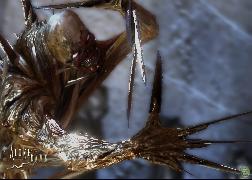Platforms: Xbox360, PS3, Wii
Release Date: 2008-06-23
Regions: USA Japan Europe
Chris’s Rating: ★★☆☆
Mixing procedural mechanics with traditional linear game play proves mediocre.
Alone in the Dark 5 is an interesting game because it tries so hard to be so many different things at once. It’s got elements of all sorts of other games, including Grand Theft Auto 3, Disaster Report, Siren, and of course, earlier Alone in the Dark games. And sometimes, the crazy mix of ideas clicks and everything works really well. Other times, the whole thing feels like a total mess. Whatever it is, Alone in the Dark 5 is a pretty unique game, and that alone makes it worthy of inspection.
Modern single player game design theory can be described with two opposing extremes. On one end of the spectrum procedural content and emergent game play; the idea is to create an interactive environment that is complex enough that the player can solve problems in all sorts of ways. This method requires a lot of systems to work well together, and is technically complex (systems like physics and collision detection usually become non-trivial), but its major advantage is that the player is free to solve problems as they see fit. The designer can set up a stage and throw some interactive elements into the mix and then let the player decide how best to approach the problem. The Grand Theft Auto series is the poster child for this kind of design.
On the other end of the spectrum is the canned challenge theory. In this case, the designer sets up specific scenarios with specific solutions, and all paths through the game are defined ahead of time. Instead of making a highly interactive environment this approach dictates that each sequence is a puzzle with exactly the elements that are needed to complete it. Canned challenge games are easier to polish because of this intrinsic determinism, and this approach has an advantage over the procedural approach in that it can very easily host a complex narrative (at the cost of player freedom and expressiveness). Games like Guitar Hero fall squarely on this side: when a note hits the strum bar line, you must play that same note with the controller in order to avoid losing points. Super Mario Bros. and most older games are similar: the move set is restricted but continued challenge comes from applying that move set to pre-determined level layouts. Resident Evil lives on this side of the fence as well.
Of course, most games are some blend of both categories. Procedural game play is very popular in Western games (thanks to GTA and a few others) while Japan seems to prefer story-heavy games that are mostly linear, pre-determined challenges. The Metal Gear Solid series is an excellent example of how the two types of design can be melded: though the progression from room to room is linear and pre-determined, each room may be approached a number of different ways, and the MGS world is populated by a fairly complicated set of rules. You can run in guns blazing, or try to find a way to sneak, or try to silently dispose of the enemies, or try to distract enemies with items, or find a hidden path around the challenge, etc.
The reason that I’ve spent so much of this review talking about two schools of game design thought is that I think Alone in the Dark 5 is best understood in the context of procedural vs linear game play. Alone in the Dark 5, like Metal Gear Solid, attempts to blend procedural and canned challenges together into a single piece. Unfortunately, the result is not nearly as cohesive as the MGS games; Alone swings wildly from one extreme to the other with very little gradation in-between. There is an attempt to make the world expressive: the game features fairly complicated rules regarding items that can be combined and set on fire. It’s possible to throw a bottle of explosive liquid and shoot it, or open it and make a trail of gas on the floor which can then be lit, or open it and throw it to make a trail, or take a rag and put it into the bottle to make a molotov cocktail, or attach tape to the bottle and stick it to things, etc. There’s also an open world area, a lot of physics, and even a GTA3-style car driving mode. But every other level or so takes the player out of the procedural world and into linear, deterministic indoor levels. In these sequences there are monsters to fight, puzzles to solve, and mazes to run, pretty much just like any other third-person survival horror game.
The problem, I think, is that the two modes of play are at odds with each other and the game itself ends up being sort of mediocre at both. The dynamic physics and collision systems that are necessary for the emergent gameplay modes end up hampering the linear levels; the simulation just isn’t precise enough to handle close-quarters movement and combat as well as games that are written specifically for that mode. On the other hand, the need to have a linear story and interleave canned levels deals a blow to the procedural side of the design: the open world is not very large or open, the car dynamics are much more limited than other open world driving games, and for all of the different ways the player can set things on fire, it turns out that shooting the can of gas is the most effective solution for almost every problem. I think that the main failing of Alone in the Dark is that it just isn’t quite competent enough to effectively host both types of game design in a single package, and the result is general mediocrity.
There are other, more minor problems that also hurt the game. I don’t like the way that enemies can only be disposed of with fire; it makes fighting a pain in the butt when there is no fire around. The body-dragging mechanic doesn’t seem to work at all because you must back up into the fire that you are trying to bring the body to; I can’t count the number of times I died while trying to burn an enemy. There are long sections in the middle of the game (like, several hours) in which there are no health items whatsoever. The story is pretty bad and the characters are never developed. Using melee weapons is really hard. It’s clear that the game got to play testing very late: the level design polish is pretty high at the beginning of the game but it degrades significantly around the middle. The last couple of challenges in the game took me twenty or thirty attempts each because of simple, easily fixable design polish issues. The game is really buggy; I encountered all sorts of physics and collision problems, and for some reason I was denied a bunch of PS3 trophies that I completed all of the requirements for. And, for all its monsters and references to Lucifer, Alone only has a couple of genuinely scary scenes.
But what saves Alone in the Dark from being a completely blah game is that every once and a while you can see a spark of brilliance in its design. The game is strongest in the open world modes. At a couple of (unfortunately short) points in the game, you find yourself in a huge section of Central Park with access to cars and items, and you must destroy “roots of evil” that have cropped up in the park. These sections are really fun: you get in a car and drive to your destination, then play a very short and contained combat level that usually involves entering an indoor area and lighting some big fires. There’s also an absolutely fantastic sequence near the beginning of the game in which you must drive through the streets of New York as a giant earth quake rips the landscape around you up; that sequence alone is so dramatic and fun that it adds significantly to the game’s final score.
And Alone in the Dark has a bunch of interesting design ideas: skippable level segments, plot summaries, a really neat item selection interface, localized damage healing that doesn’t fall into the Call of Cthulhu trap of being too complicated, etc. The game is playable in both third and first person (something I haven’t seen done well since The Suffering), and when the world elements click, there’s a lot of fun ways to solve problems.
So, my conclusion about Alone in the Dark is that it’s overly ambitious. There are a lot of interesting ideas here but the tech and level design are just not quite up to the level of quality necessary to pull it off. It’s not a bad horror game by any stretch of the imagination, but considering how much work must have gone into all of the innovative features of the game, it’s a bit disappointing that it’s not really that great of a horror game either.



